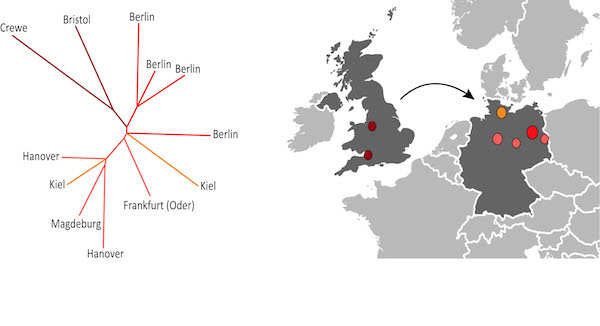public health workers
See the following -
Closing the Referral Problem in Distributed Care Networks
 There have been any number of people and companies working tirelessly to solve healthcare's interoperability challenges. Hospitals, EHR software companies, Health Information Exchanges (HIEs), Federal and State governments, payers, and others have developed, tested, and implemented many in-house or vendor-built solutions to try to clear this hurdle. Recently, consumer technology vendors and patient-centered innovation programs have begun to make significant strides on directly expanding patients access to their own records. This is great news for patients, but when I am a patient, I also want my doctors and other caregivers to be able to communicate about me when needed. So, making me responsible for stewarding pieces of my record between them doesn't solve the challenge. Especially if I have received care in three or four different places or worse yet, become incapacitated.
There have been any number of people and companies working tirelessly to solve healthcare's interoperability challenges. Hospitals, EHR software companies, Health Information Exchanges (HIEs), Federal and State governments, payers, and others have developed, tested, and implemented many in-house or vendor-built solutions to try to clear this hurdle. Recently, consumer technology vendors and patient-centered innovation programs have begun to make significant strides on directly expanding patients access to their own records. This is great news for patients, but when I am a patient, I also want my doctors and other caregivers to be able to communicate about me when needed. So, making me responsible for stewarding pieces of my record between them doesn't solve the challenge. Especially if I have received care in three or four different places or worse yet, become incapacitated.
- Login to post comments
Department of Health APIs to Expand Web Content
 Application Programming Interfaces (APIs) appeal mostly to statisticians and researchers whose careers depend on access to data. But these programming tools are also a useful part of a Web that is becoming increasingly supple and sophisticated. I have written a series of articles about the use of APIs to share and run analytics on patient data, but today I’ll cover a cool use of an API developed by the Department of Health and Human Services for disseminating educational material. The locus for this activity started with the wealth of information created by the Centers for Disease Control for doctors, public health workers, and the general public. Striving to help the public understand vaccinations, West Nile fever, Ebola (when that was a major publicissue), and even everyday conditions such as diabetes, the CDC realized they had to make their content simple to embed in web sites for allthose audiences.
Application Programming Interfaces (APIs) appeal mostly to statisticians and researchers whose careers depend on access to data. But these programming tools are also a useful part of a Web that is becoming increasingly supple and sophisticated. I have written a series of articles about the use of APIs to share and run analytics on patient data, but today I’ll cover a cool use of an API developed by the Department of Health and Human Services for disseminating educational material. The locus for this activity started with the wealth of information created by the Centers for Disease Control for doctors, public health workers, and the general public. Striving to help the public understand vaccinations, West Nile fever, Ebola (when that was a major publicissue), and even everyday conditions such as diabetes, the CDC realized they had to make their content simple to embed in web sites for allthose audiences.
- Login to post comments
Feds Ratchet Up Public Health, Tech Efforts To Battle Ebola
It appears almost definite at this point that the Ebola outbreak is likely to get worse, and very much so, before it shows any signs of lessening. The U.S. Centers for Disease Prevention and Control, in fact, projected that the number of infected people could potentially double every 20 days if nothing is done — a figure that could skyrocket to 1.4 million by January’s end...
- Login to post comments
Hiding Our Heads in the Sand - Why the US is Unprepared for Pandemics and Disasters
 A new report from the Trust for America's Health minces no words. President and CEO John Auerbach charges: COVID-19 has shined a harsh spotlight on the country's lack of preparedness for dealing with threats to Americans' well-being. Years of cutting funding for public health and emergency preparedness programs has left the nation with a smaller-than-necessary public health workforce, limited testing capacity, an insufficient national stockpile, and archaic disease tracking systems - in summary, twentieth-century tools for dealing with twenty-first-century challenges.
A new report from the Trust for America's Health minces no words. President and CEO John Auerbach charges: COVID-19 has shined a harsh spotlight on the country's lack of preparedness for dealing with threats to Americans' well-being. Years of cutting funding for public health and emergency preparedness programs has left the nation with a smaller-than-necessary public health workforce, limited testing capacity, an insufficient national stockpile, and archaic disease tracking systems - in summary, twentieth-century tools for dealing with twenty-first-century challenges.
- Login to post comments
Tracking Deadly Superbug Infections Across Europe with Web-Based Open Tools that Use Genome Sequencing and Open APIs
 For the first time, scientists have shown that MRSA (methicillin-resistant Staphylococcus aureus) and other antibiotic-resistant ‘superbug’ infections can be tracked across Europe by combining whole-genome sequencing with a web-based system. In mBio today (5 May 2016) researchers at Imperial College London and the Wellcome Trust Sanger Institute worked with a European network representing doctors in 450 hospitals in 25 countries to successfully interpret and visualise the spread of drug-resistant MRSA...
For the first time, scientists have shown that MRSA (methicillin-resistant Staphylococcus aureus) and other antibiotic-resistant ‘superbug’ infections can be tracked across Europe by combining whole-genome sequencing with a web-based system. In mBio today (5 May 2016) researchers at Imperial College London and the Wellcome Trust Sanger Institute worked with a European network representing doctors in 450 hospitals in 25 countries to successfully interpret and visualise the spread of drug-resistant MRSA...
- Login to post comments